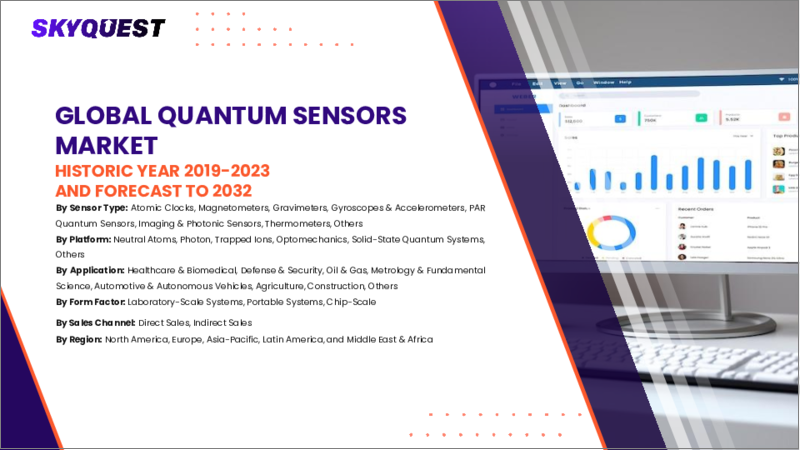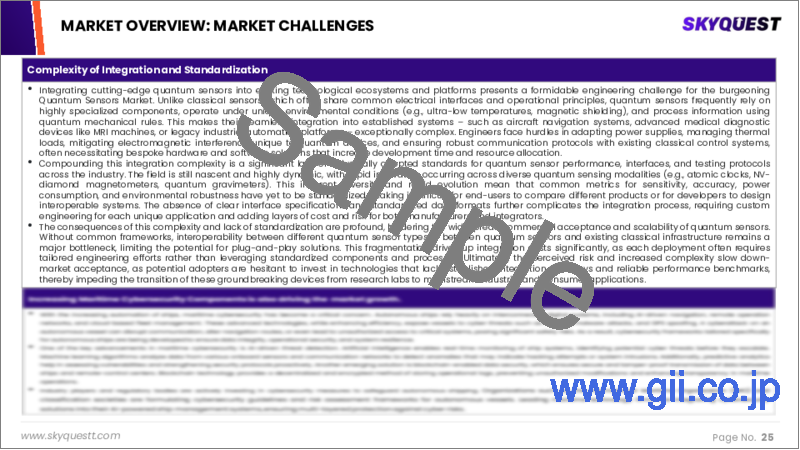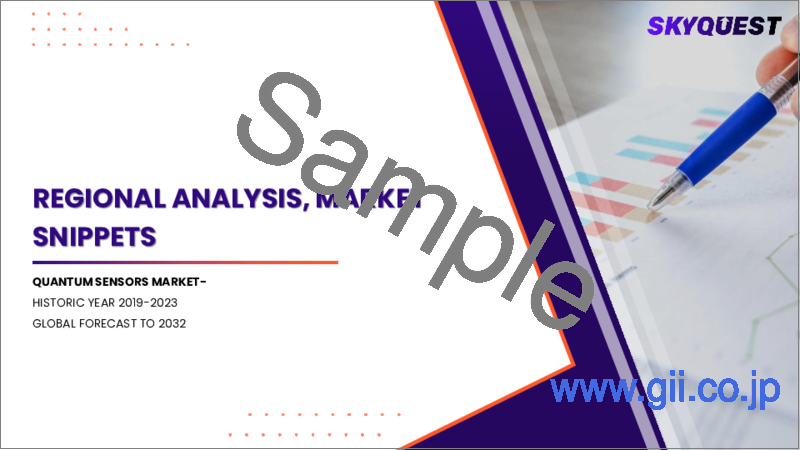|
|
市場調査レポート
商品コード
1734492
量子センサーの市場規模、シェア、成長分析、プラットフォーム別、製品タイプ別、用途別、最終用途別、地域別 - 産業予測、2025年~2032年Quantum Sensors Market Size, Share, and Growth Analysis, By Platform (Neutral Atoms, Trapped Ions), By Product Type (Atomic Clocks, Magnetic Sensors), By Application, By End Use, By Region - Industry Forecast 2025-2032 |
||||||
|
|||||||
| 量子センサーの市場規模、シェア、成長分析、プラットフォーム別、製品タイプ別、用途別、最終用途別、地域別 - 産業予測、2025年~2032年 |
|
出版日: 2025年05月18日
発行: SkyQuest
ページ情報: 英文 192 Pages
納期: 3~5営業日
|
全表示
- 概要
- 目次
量子センサーの世界市場規模は2023年に3億1,140万米ドルとなり、2024年の3億5,811万米ドルから2032年までには10億9,547万米ドルに拡大し、予測期間(2025年~2032年)のCAGRは15.0%で成長する見通しです。
市場では、量子センサーの小型化・統合化が大きく進展しており、開発者は既存のインフラにシームレスに適合したり、単独で機能したりする小型でポータブルなデバイスの開発に注力しています。このようなセンサーの小型化・統合化は、センサーの汎用性、使いやすさ、費用対効果を向上させ、様々な産業への応用の可能性を広げます。特筆すべきは、量子センサーが量子通信や暗号技術、特に量子鍵配布(QKD)技術で支持を集めていることで、これらのセンサーを活用して量子状態を正確に検出・測定し、安全な通信を実現しています。高度なセキュリティ対策への要求が高まる中、先進的な量子センサーの役割は、堅牢で信頼性の高い通信ネットワークを確立するための基本的なものとなりつつあります。
目次
イントロダクション
- 調査の目的
- 調査範囲
- 定義
調査手法
- 情報調達
- 二次と一次データの方法
- 市場規模予測
- 市場の前提条件と制限
エグゼクティブサマリー
- 世界市場の見通し
- 供給と需要の動向分析
- セグメント別機会分析
市場力学と見通し
- 市場概要
- 市場規模
- 市場力学
- 促進要因と機会
- 抑制要因と課題
- ポーターの分析
主要な市場の考察
- 主要な成功要因
- 競合の程度
- 主要な投資機会
- 市場エコシステム
- 市場の魅力指数(2024年)
- PESTEL分析
- マクロ経済指標
- バリューチェーン分析
- 価格分析
量子センサー市場規模:プラットフォーム別・CAGR(2025年~2032年)
- 市場概要
- 中性原子
- 捕捉されたイオン
- 核磁気共鳴
- 光学機械工学
- 光子
- ダイヤモンドの欠陥
- 超伝導体
量子センサー市場規模:製品タイプ別・CAGR(2025年~2032年)
- 市場概要
- 原子時計
- 磁気センサー
- 光合成有効放射線(PAR)量子センサー
- 重力計・加速度計
量子センサー市場規模:用途別・CAGR(2025年~2032年)
- 市場概要
- 環境モニタリング
- 医療画像
- 精密測定
- ライダー
量子センサー市場規模:最終用途別・CAGR(2025年~2032年)
- 市場概要
- 航空宇宙・防衛
- 石油・ガス
- 農業・環境
- 建設・鉱業
- 自動車・輸送
- ヘルスケア
- その他
量子センサー市場規模・CAGR(2025年~2032年)
- 北米
- 米国
- カナダ
- 欧州
- ドイツ
- スペイン
- フランス
- 英国
- イタリア
- その他欧州地域
- アジア太平洋
- 中国
- インド
- 日本
- 韓国
- その他アジア太平洋
- ラテンアメリカ
- ブラジル
- その他ラテンアメリカ地域
- 中東・アフリカ
- GCC諸国
- 南アフリカ
- その他中東・アフリカ
競合情報
- 上位5社の比較
- 主要企業の市場ポジショニング(2024年)
- 主な市場企業が採用した戦略
- 最近の市場動向
- 企業の市場シェア分析(2024年)
- 主要企業の企業プロファイル
- 企業の詳細
- 製品ポートフォリオ分析
- 企業のセグメント別シェア分析
- 収益の前年比比較(2022年~2024年)
主要企業プロファイル
- Hamamatsu Photonics(Japan)(Public)
- M Squared Lasers(United Kingdom)
- Qnami(Switzerland)
- Q-CTRL(Australia)
- Nomad Atomics(Australia)
- Kistler Group(Switzerland)
- KWAN-TEK(France)
- QNu Labs(India)
- Copenhagen Quantum Solutions(CQS)(Denmark)
- Quantum Sensory Technologies(QST)(France)
- Berlin Quantum Works(BQW)(Germany)
- Amsterdam Quantum Labs(AQL)(Netherlands)
- Quantum Precision Systems(QPS)(Austria)
- Helsinki Quantum Design(HQD)(Finland)
- QuSpin(Israel)
- Aquark Technologies(United Kingdom)
- Menlo Systems GmbH(Germany)
- Nu Quantum(United Kingdom)
結論と提言
Global Quantum Sensors Market size was valued at USD 311.4 million in 2023 and is poised to grow from USD 358.11 million in 2024 to USD 1095.47 million by 2032, growing at a CAGR of 15.0% during the forecast period (2025-2032).
The market is witnessing a significant trend towards the miniaturization and integration of quantum sensors, with developers focusing on creating compact and portable devices that can seamlessly fit into existing infrastructures or function independently. This shift towards smaller, integrated sensors enhances their versatility, user-friendliness, and cost-effectiveness, expanding their potential applications across various industries. Notably, quantum sensors are gaining traction in quantum communication and cryptography, particularly through Quantum Key Distribution (QKD) technology, which leverages these sensors to accurately detect and measure quantum states, ensuring secure communication. As the demand for sophisticated security measures increases, the role of advanced quantum sensors is becoming fundamental in establishing robust and reliable communication networks.
Top-down and bottom-up approaches were used to estimate and validate the size of the Global Quantum Sensors market and to estimate the size of various other dependent submarkets. The research methodology used to estimate the market size includes the following details: The key players in the market were identified through secondary research, and their market shares in the respective regions were determined through primary and secondary research. This entire procedure includes the study of the annual and financial reports of the top market players and extensive interviews for key insights from industry leaders such as CEOs, VPs, directors, and marketing executives. All percentage shares split, and breakdowns were determined using secondary sources and verified through Primary sources. All possible parameters that affect the markets covered in this research study have been accounted for, viewed in extensive detail, verified through primary research, and analyzed to get the final quantitative and qualitative data.
Global Quantum Sensors Market Segments Analysis
Global Quantum Sensors Market is segmented by Platform, Product Type, Application, End Use, and region. Based on Platform, the market is segmented into Neutral Atoms, Trapped Ions, Nuclear Magnetic Resonance, Optomechanics, Photons, Defects In Diamonds and Superconductors. Based on Product Type, the market is segmented into Atomic Clocks, Magnetic Sensors, photosynthetically active radiation (PAR), Quantum Sensors and Gravimeters, and Accelerometers. Based on Application, the market is segmented into Environmental monitoring, Medical imaging, Precision measurement and LiDAR. Based on End Use, the market is segmented into Aerospace & Defense, Oil & Gas, Agriculture & Environment, Construction & Mining, Automotive & Transportation, Healthcare and Others. Based on region, the market is segmented into North America, Europe, Asia Pacific, Latin America and Middle East & Africa.
Driver of the Global Quantum Sensors Market
The expansion of the global quantum sensors market is significantly influenced by advancements in quantum computing technology. As quantum computing systems evolve, there is an increasing need for high-sensitivity and precision measurement tools, leading to a heightened demand for quantum sensors. This integration of sensors with quantum computing is not only fueling innovation but also boosting demand across various sectors, including healthcare, military applications, and transportation. Consequently, the growing reliance on quantum sensors in these fields underscores their critical role in enhancing measurement accuracy and detection capabilities, thereby propelling the overall market growth in the industry.
Restraints in the Global Quantum Sensors Market
The Global Quantum Sensors market faces significant constraints primarily due to the substantial investments required for infrastructure, technology, and research development. The high production costs associated with quantum sensors, coupled with the challenges related to their integration into existing systems, hinder their widespread adoption. Additionally, the potential market growth in specific sectors may be limited, as small businesses and resource-constrained industries often lack the necessary capital to invest in these advanced technologies. This financial barrier restricts the broader utilization and commercialization of quantum sensors, thereby impacting the overall market landscape.
Market Trends of the Global Quantum Sensors Market
The global quantum sensors market is witnessing a notable trend towards miniaturization, driven by advancements in technology that allow for the development of smaller, lighter quantum sensors. This evolution is facilitating integration into a range of consumer and commercial devices, including wearables and smartphones, enhancing their accessibility and affordability. As quantum sensors become increasingly compact, they are poised to expand their applications across diverse industries, from healthcare to environmental monitoring, ultimately accelerating adoption rates. This trend not only signifies technological progress but also opens new avenues for innovation, making quantum sensing a pivotal component of future smart technologies.
Table of Contents
Introduction
- Objectives of the Study
- Scope of the Report
- Definitions
Research Methodology
- Information Procurement
- Secondary & Primary Data Methods
- Market Size Estimation
- Market Assumptions & Limitations
Executive Summary
- Global Market Outlook
- Supply & Demand Trend Analysis
- Segmental Opportunity Analysis
Market Dynamics & Outlook
- Market Overview
- Market Size
- Market Dynamics
- Drivers & Opportunities
- Restraints & Challenges
- Porters Analysis
- Competitive rivalry
- Threat of substitute
- Bargaining power of buyers
- Threat of new entrants
- Bargaining power of suppliers
Key Market Insights
- Key Success Factors
- Degree of Competition
- Top Investment Pockets
- Market Ecosystem
- Market Attractiveness Index, 2024
- PESTEL Analysis
- Macro-Economic Indicators
- Value Chain Analysis
- Pricing Analysis
Global Quantum Sensors Market Size by Platform & CAGR (2025-2032)
- Market Overview
- Neutral Atoms
- Trapped Ions
- Nuclear Magnetic Resonance
- Optomechanics
- Photons
- Defects In Diamonds
- Superconductors
Global Quantum Sensors Market Size by Product Type & CAGR (2025-2032)
- Market Overview
- Atomic Clocks
- Magnetic Sensors
- Photosynthetically active radiation (PAR) Quantum Sensors
- Gravimeters and Accelerometers
Global Quantum Sensors Market Size by Application & CAGR (2025-2032)
- Market Overview
- Environmental monitoring
- Medical imaging
- Precision measurement
- LiDAR
Global Quantum Sensors Market Size by End Use & CAGR (2025-2032)
- Market Overview
- Aerospace & Defense
- Oil & Gas
- Agriculture & Environment
- Construction & Mining
- Automotive & Transportation
- Healthcare
- Others
Global Quantum Sensors Market Size & CAGR (2025-2032)
- North America (Platform, Product Type, Application, End Use)
- US
- Canada
- Europe (Platform, Product Type, Application, End Use)
- Germany
- Spain
- France
- UK
- Italy
- Rest of Europe
- Asia Pacific (Platform, Product Type, Application, End Use)
- China
- India
- Japan
- South Korea
- Rest of Asia-Pacific
- Latin America (Platform, Product Type, Application, End Use)
- Brazil
- Rest of Latin America
- Middle East & Africa (Platform, Product Type, Application, End Use)
- GCC Countries
- South Africa
- Rest of Middle East & Africa
Competitive Intelligence
- Top 5 Player Comparison
- Market Positioning of Key Players, 2024
- Strategies Adopted by Key Market Players
- Recent Developments in the Market
- Company Market Share Analysis, 2024
- Company Profiles of All Key Players
- Company Details
- Product Portfolio Analysis
- Company's Segmental Share Analysis
- Revenue Y-O-Y Comparison (2022-2024)
Key Company Profiles
- Hamamatsu Photonics (Japan) (Public)
- Company Overview
- Business Segment Overview
- Financial Updates
- Key Developments
- M Squared Lasers (United Kingdom)
- Company Overview
- Business Segment Overview
- Financial Updates
- Key Developments
- Qnami (Switzerland)
- Company Overview
- Business Segment Overview
- Financial Updates
- Key Developments
- Q-CTRL (Australia)
- Company Overview
- Business Segment Overview
- Financial Updates
- Key Developments
- Nomad Atomics (Australia)
- Company Overview
- Business Segment Overview
- Financial Updates
- Key Developments
- Kistler Group (Switzerland)
- Company Overview
- Business Segment Overview
- Financial Updates
- Key Developments
- KWAN-TEK (France)
- Company Overview
- Business Segment Overview
- Financial Updates
- Key Developments
- QNu Labs (India)
- Company Overview
- Business Segment Overview
- Financial Updates
- Key Developments
- Copenhagen Quantum Solutions (CQS) (Denmark)
- Company Overview
- Business Segment Overview
- Financial Updates
- Key Developments
- Quantum Sensory Technologies (QST) (France)
- Company Overview
- Business Segment Overview
- Financial Updates
- Key Developments
- Berlin Quantum Works (BQW) (Germany)
- Company Overview
- Business Segment Overview
- Financial Updates
- Key Developments
- Amsterdam Quantum Labs (AQL) (Netherlands)
- Company Overview
- Business Segment Overview
- Financial Updates
- Key Developments
- Quantum Precision Systems (QPS) (Austria)
- Company Overview
- Business Segment Overview
- Financial Updates
- Key Developments
- Helsinki Quantum Design (HQD) (Finland)
- Company Overview
- Business Segment Overview
- Financial Updates
- Key Developments
- QuSpin (Israel)
- Company Overview
- Business Segment Overview
- Financial Updates
- Key Developments
- Aquark Technologies (United Kingdom)
- Company Overview
- Business Segment Overview
- Financial Updates
- Key Developments
- Menlo Systems GmbH (Germany)
- Company Overview
- Business Segment Overview
- Financial Updates
- Key Developments
- Nu Quantum (United Kingdom)
- Company Overview
- Business Segment Overview
- Financial Updates
- Key Developments






